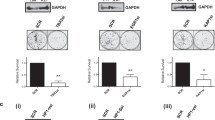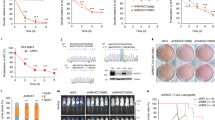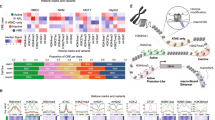Abstract
ARHI is a maternally imprinted tumor suppressor gene whose expression is markedly downregulated in breast cancer. Reactivation of ARHI expression in breast cancer cells is associated with increased histone H3 acetylation and decreased lysine 9 methylation of histone H3. An ARHI promoter segment that spanned bases −420 to +58 (designated the P2 region) exhibits significantly higher promoter activity in normal cells than in cancer cells. To better understand the molecular mechanisms contributing to this differential transcriptional activity, we sought to identify transcription factors that bind to the P2 region of the ARHI promoter and regulate its activity. Sequence analysis and oligonucleotide competition in electrophoretic mobility shift assays identified an A2 fragment containing an E2F-binding site. Using specific antibodies in supershift assays, we have shown that anti-E2F1 and 4 antibodies can supershift the A2–protein complexes, whereas anti-E2F2 and 6 antibodies cannot, demonstrating that the A2 fragment interacts with specific members of the E2F family proteins.
When compared with normal breast epithelial cells, breast cancer cells have significantly elevated expression of E2F1, 4 and increased E2F DNA-binding activity. Moreover, chromatin immunoprecipitation experiments revealed that both E2F1 and 4 bind to the ARHI promoter in breast cancer cells in vivo. This binding was reduced when the cells were treated with the histone deacetylase (HDAC) inhibitor – trichostatin A (TSA). When SKBr3 cells were cotransfected with an ARHI/luciferase reporter and E2F-expression vectors, E2F1 and 4 reduced ARHI promoter activity 2–3-fold, and this reduction could be reversed by TSA treatment. The negative regulation by E2F–HDAC complexes could also be reduced by small interfering RNA of E2F1 and 4. While the retinoblastoma protein, pRB, alone had no effect on ARHI promoter activity, repression by E2F1, but not E2F4, was enhanced by the coexpression of pRB. Taken together, our results suggest that E2F1, 4 and their complexes with HDAC play an important role in downregulating the expression of the tumor suppressor gene ARHI in breast cancer cells.
This is a preview of subscription content, access via your institution
Access options
Subscribe to this journal
Receive 50 print issues and online access
$259.00 per year
only $5.18 per issue
Buy this article
- Purchase on Springer Link
- Instant access to full article PDF
Prices may be subject to local taxes which are calculated during checkout







Similar content being viewed by others
References
Attwooll C, Denchi EL, Helin K . (2004). EMBO J 23: 4709–4716.
Blais A, Monte D, Pouliot F, Labrie C . (2002). J Biol Chem 277: 31679–31693.
Bracken AP, Ciro M, Cocito A, Helin K . (2004). Trends Biochem Sci 29: 409–417.
Brehm A, Miska EA, McCance DJ, Reid JL, Bannister AJ, Kouzarides T . (1998). Nature 391: 597–601.
Cam H, Dynlacht BD . (2003). Cancer Cell 3: 311–316.
Chadee DN, Hendzel MJ, Tylipski CP, Allis CD, Bazett-Jones DP, Wright JA et al. (1999). J Biol Chem 274: 24914–24920.
Dyson N . (1998). Genes Dev 12: 2245–2262.
Fujii S, Luo RZ, Yuan J, Kadota M, Oshimura M, Dent SR et al. (2003). Hum Mol Genet 12: 1791–1800.
Gao G, Bracken AP, Burkard K, Pasini D, Classon M, Attwooll C et al. (2003). Mol Cell Biol 23: 2821–2833.
Hisatomi H, Nagao K, Wakita K, Kohno N . (2002). Oncology 62: 136–140.
Lu ZH, Chen J, Gu LJ, Luo YF, Gu CF . (2001). Zhongguo Yi Xue Ke Xue Yuan Xue Bao 23: 324–327 (Chinese).
Luo RZ, Peng H, Xu F, Bao J, Pang Y, Pershad R et al. (2001). Biochim Biophys Acta 1519: 216–222.
Müller H, Bracken AP, Vernell R, Moroni MC, Christians F, Grassilli E et al. (2001). Genes Dev 15: 267–285.
Peng HQ, Xu FJ, Pershad R, Hogg D, Gray JW, Berchuck A et al. (2000). Int J Cancer 86: 690–694.
Rayman JB, Takahashi Y, Indjeian VB, Dannenberg JH, Catchpole S, Watson RJ et al. (2002). Genes Dev 16: 933–947.
Ren B, Cam H, Takahashi Y, Volkert T, Terragni J, Young R et al. (2002). Genes Dev 16: 245–256.
Sapienza C . (1991). Biochim Biophys Acta 1072: 51–61.
Shi Z, Zhou X, Xu L, Zhang T, Hou Y, Zhu W et al. (2002). Zhonghua Zhong Liu Za Zhi 24: 475–478 (Chinese).
Takahashi Y, Rayman JB, Dynlacht BD . (2000). Genes Dev 14: 804–816.
Tao Y, Kassatly RF, Cress WD, Horowitz JM . (1997). Mol Cell Biol 17: 6994–7007.
Vigo E, Muller H, Prosperini E, Hateboer G, Cartwright P, Moroni MC et al. (1999). Mol Cell Biol 19: 6379–6395.
Wang L, Hoque A, Luo RZ, Yuan J, Liu J, Sahin AA et al. (2003). Clin Cancer Res 9: 3660–3666.
Weber F, Aldred MA, Morrison CD, Plass C, Frilling A, Broelsch CE et al. (2005). J Clin Endocrinol Metab 90: 1149–1155.
Yoshida K, Inoue I . (2004). Oncogene 23: 3802–3812.
Yu Y, Xu F, Fang X, Zhao S, Li Y, Cuevas B et al. (1999). Proc Natl Acad Sci USA 96: 214–219.
Yuan J, Luo RZ, Fujii S, Wang L, Hu W, Andreeff M et al. (2003). Cancer Res 63: 4174–4180.
Zhang SY, Liu SC, Al-Saleem LF, Holloran D, Babb J, Guo X et al. (2000). Cancer Epidemiol Biomarker Prev 9: 395–401.
Acknowledgements
This work was supported by the National Institutes of Health Grants CA 80957, CA 64602 and National Foundation for Cancer Research (NFCR LF 2004-00009224HM). We gratefully acknowledge Drs Hongji Xu and Shixue Hu at the MD Anderson Cancer Center for providing SAOS-2 cells, pRB expression vector and technical assistance.
Author information
Authors and Affiliations
Corresponding author
Rights and permissions
About this article
Cite this article
Lu, Z., Luo, R., Peng, H. et al. E2F–HDAC complexes negatively regulate the tumor suppressor gene ARHI in breast cancer. Oncogene 25, 230–239 (2006). https://doi.org/10.1038/sj.onc.1209025
Received:
Revised:
Accepted:
Published:
Issue Date:
DOI: https://doi.org/10.1038/sj.onc.1209025
Keywords
This article is cited by
-
Differential regulation of mammalian and avian ATOH1 by E2F1 and its implication for hair cell regeneration in the inner ear
Scientific Reports (2021)
-
E2F1-mediated repression of WNT5A expression promotes brain metastasis dependent on the ERK1/2 pathway in EGFR-mutant non-small cell lung cancer
Cellular and Molecular Life Sciences (2021)
-
ARHI (DIRAS3)-mediated autophagy-associated cell death enhances chemosensitivity to cisplatin in ovarian cancer cell lines and xenografts
Cell Death & Disease (2015)
-
JMJD2A-dependent silencing of Sp1 in advanced breast cancer promotes metastasis by downregulation of DIRAS3
Breast Cancer Research and Treatment (2014)
-
Dmp1 and tumor suppression
Oncogene (2007)



